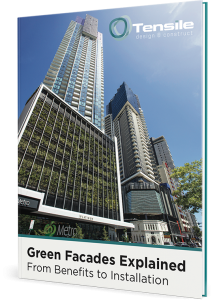Fall protection barriers on multi-storey buildings, bridges and other structures must comply with strict safety codes in Australia. But from an architect’s perspective, the appearance of the barrier is also a priority.
A common challenge for architects is how to ensure a barrier fits with the design of the structure. In a building designed in a minimalist light-filled style for example, a heavy and cumbersome barrier is unlikely to look good!
This is why tensile safety barriers made from lightweight materials are growing in popularity – because of their near-transparency and adaptability to so many architectural styles and structures.
Tensile innovations for fall protection
At Tensile, we use Jakob stainless steel in the form of mesh or wire rope to build fall protection barriers. Webnet barriers look so lightweight, they might not appear to have the strength and durability required to meet safety codes. However, the barrier materials are made from grade 316 stainless steel that undergoes rigorous independent testing for strength and break-loads.
We listen to our clients to gain an understanding of their design goals in order to create barriers that enhance the overall look of the structure. Jakob materials can be configured to suit project design needs, with a choice of cable dimensions, mesh aperture sizes and components. Crucially, we use precision engineering to arrive at the correct tensioning for the needs of each individual barrier.
Here are three projects that demonstrate this, while looking great!
1. Stonnington City Council office renovation
For its office makeover, the council needed a staircase balustrade that would fulfill the necessary safety requirements, while facilitating development of a ‘green’, light-filled office.
The Tensile vertical cable safety balustrade we installed doubles up as a substrate for climbing plants – creating an internal green facade. The resulting barrier meets the dual needs of safety and aesthetics. It also allows for natural light entry and contributes to environmental improvements.
This type of solution is only possible with the use of tensioned wire rope or mesh, and more than demonstrates the versatility of tensile stainless-steel barriers.

2. Northern Beaches Hospital mesh barrier
The hospital had two seven-storey atriums with glass balustrades but that required additional fall protection barriers. It was important to the client that the new barriers looked like they were part of the original design.
We used Webnet mesh to create full-height barriers for maximum safety. The Webnet has decorative metal plates arranged to align with the vertical fretwork on the glass panels.
The finished result demonstrates how Webnet can not only blend in with existing architectural design but go even further by enhancing it.
3. Monash University LTB atrium barrier
Monash initially considered using glass to create a transparent barrier for its internal light-filled atrium.
However, stainless steel cables proved to be more practical and cost-effective – partly because the glass panels needed to be very tall to prevent climbing, which would have added to the cost.
The installed cables provide a full-height barrier, that is not only fully non-climbable and low maintenance but that also complements the building’s architectural style. It’s lightweight, filigreed appearance allows for connection between floors, airflow and sightlines.
If you have a project in mind that needs a robust and attractive fall protection barrier, contact us today!







































